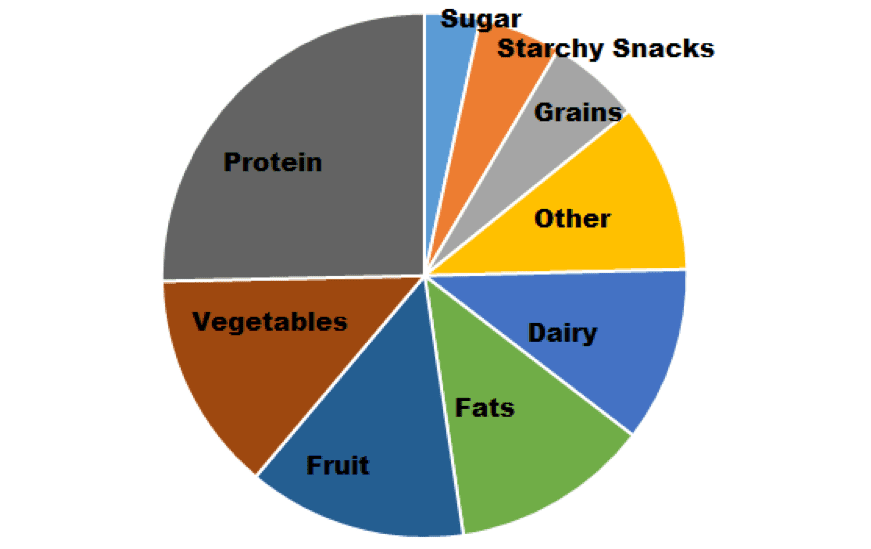
I was shocked to learn that Americans spend nearly a trillion dollars on groceries, and another another trillion eaten away from home, according to the USDA. So the real question is: how can you shop for groceries on a budget?

My family of three spends considerably less than average, and we often invite others over to eat with us. And it’s not all beans and rice — we eat an omnivorous diet, while keeping our budget in mind.
But I don’t plan meals, I rarely use a grocery list, and I refuse to use coupons or go to multiple stores. In fact, other than not eating out, I wasn’t sure why our spending came in lower than average.
To figure out how we keep our spending low, I tracked our spending and consumption for 28 days in an attempt to find clues to our very tempting food bill. This is what I learned.
Budget Breakdown
My first step in analyzing how much of our monthly budget went toward food was to record our total monthly food spending, in addition to how often we make meals for ourselves as well as friends and family.
Our total food spending was easy enough to find using a monthly debit card statement, and amounted to $356.15, spread across six trips to the grocery store. Keep in mind we live in Raleigh, North Carolina, and food costs can vary throughout the country.
Besides the primary eaters in our household (myself, my husband Rob, and our son), I determined who our secondary eaters were, and how many meals they consumed. This included our in-laws, our housemate, and various other friends.
After analyzing how many meals each individual consumed, I divided up our total monthly grocery bill by the number of meals and came to the following statistics:
Average Meal Price Per Person (Includes Other Eaters in Calculations)

Breakfast: $0.71
Lunch: $0.76
Dinner: $1.50
Snacks and Desserts: $0.77
I continued with my analysis and broke down our spending as it relates to the food pyramid.
It turns out 59 percent of our spending went toward proteins, vegetables, fruit, and whole grains. Eight percent of our spending went toward sugary and starchy snacks. The remaining 33 percent was spent on dairy, fatty foods, and other miscellaneous food-related expenses:
| Food Group | Amount in Dollars | Percentage of Total Spent |
| Sugary Snacks | $12.13 | 3.5 percent |
| Starchy Snacks | $18.14 | 5 percent |
| Grains | $20.37 | 6 percent |
| Other | $37.04 | 10.5 percent |
| Dairy | $38.42 | 11 percent |
| Fats | $43.55 | 12 percent |
| Fruit | $48.04 | 13.5 percent |
| Vegetable | $48.24 | 13.5 percent |
| Protein | $90.22 | 25 percent |
Visualizing how our money was being spent helped to illuminate why our monthly food costs were so low. And after I had a good idea of where my money was going, I developed the following recommendations for budget grocery shopping:
How to Grocery Shop on a Budget

1. Snack on Cheap Junk (Kidding, But Not Really)
During the course of this exercise, I realized that we eat too many junky snacks: granola, graham crackers, popcorn, and popsicles were frequent offenders.
When I realized how much junk we ate, I added healthier options like green smoothies, peanut-butter toast, and oatmeal to the rotation. While these snacks cost more and require some prep, the health benefits vastly outweigh the costs.
In my analysis, I classified desserts as snacks. We enjoy an abundance of homemade treats, as I love baking. Besides, cookies and cakes cost only a few dollars when made from scratch. To keep our consumption in check, I make treats only for group gatherings and celebrations.
2. Don’t Fear Fat
Fats accounted for $43.55 during the 28 days. For many people, this is shockingly high, but I don’t fear fat. Plant-based fats (avocados, olive oil, nuts, etc.) offer health benefits, and we rely on them to fill up at a low price.
In fact, including healthier, monounsaturated fats can have beneficial effects on the body. “Nuts, avocados, and olives are all rich in monounsaturated fats,” says health scientist and researcher Bart Wolbers of Nature Builds.
“Benefits allocated to monounsaturated fats include improving blood panels — such as cholesterol levels — protection against heart disease, aiding in weight loss, lowering inflammation, boosting brain function, and regulating blood sugar,” Wolbers says.
On the other hand, mayo, bacon, butter, and cream cheese — which primarily contain saturated fats — don’t offer as many benefits other than being delicious. But we still shared some of those delicious fatty condiments and baked goods with friends.
“To be sure, no one proposes to eliminate all saturated fats. Everyone agrees you need some of them,” Wolbers adds. “But if you’re consuming only saturated fat-rich food, you’re missing out on all the health benefits of monounsaturated fats.”
3. Buy Only Food You Eat
During tracking, I threw away one zucchini, part of an avocado, and a few mushy grapes. Americans toss nearly 150,000 pounds of food each day, according to researchers at the U.S. Department of Agriculture.
To avoid food waste, I purchase food that I know my family will eat.
I allow myself to buy an ingredient I’ve never used before if I can quickly find a recipe for it. Otherwise, I leave the product on the shelf. Doing so is both a frugal choice, as it reduces your total monthly food costs, but it’s also an environmentally friendly decision to reduce wasted food. It’s a win-win for your wallet as well as for Mother Earth.
4. Limit Leftovers
My family and I don’t like to eat leftovers, so when I cook, I aim to make the exact amount of food that we’ll eat. If I make too much, my husband or our housemate will usually split an extra helping of food. The exception to this rule is when I roast or grill meat. During those meals, I make two or three times as much meat as we need so that I can reuse it in another meal.
To that extent, if you’re cooking from a recipe, make sure to follow directions to net the correct serving size. If you’re hungry while cooking, you might end up adding an additional pepper or onion in anticipation of a big meal, only to find yourself filling up faster than expected.
5. Scout Out Deals
My family eats loads of meat, fruits, and vegetables, but we spent just $187.50 on these products. I get meat deals by shopping at Aldi on Friday mornings when my local store has a clearance sale on meat. I buy some discount produce, but the bulk of our produce comes from “Special Buy” promotions.
Spring and summer bring an abundance of cheap produce, and we gorge on it. The rest of the year, we rely on frozen vegetables and oranges to keep scurvy at bay. Check your community newspaper insert, and stay abreast of grocery stores on social media, to scope out local deals and help you shop on a budget.
6. Develop Food Systems
Some people clip coupons, create a meticulous meal plan, and write out a grocery list. I’m too lazy for all that. We keep expenses low by having a food system instead of a meal plan. Most nights we eat stir-fry, tacos, or rice bowls because these meals are flexible. I use whatever meat and produce that I bought on sale to make the meal.
When I have time, I cook and freeze a batch of meatballs or grilled chicken, and I aim to chop up produce the day I get home from the grocery store. Preparing meal components allows me to whip up meals without having a specific meal plan.
7. Learn to Cook
Cooking is a skill, and it takes time and energy to learn to do it in a way that works for your family. I learned basic cooking skills from my mom, but I read food blogs, watch cooking tutorials, and practice various techniques so that we can eat high-quality food at home for cheaper.
A simple web search of “easy recipes” can be a great entry point to the world of the culinary arts, and you can build your skillset from novice to master chef if you keep at it.
By dedicating the right time to learning how to cook well for a group of people, while simultaneously getting the best bargain on food and planning ahead, it’s easy to eat healthily (and tastily) while still grocery shopping on a budget.
Additional reporting by Connor Beckett McInerney.













